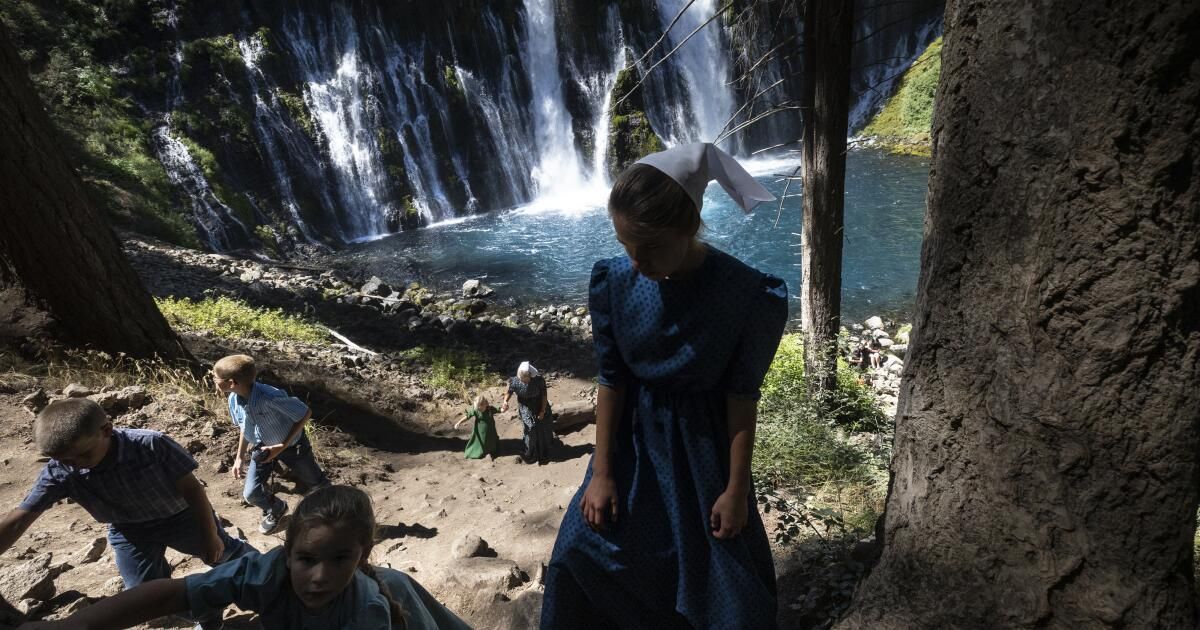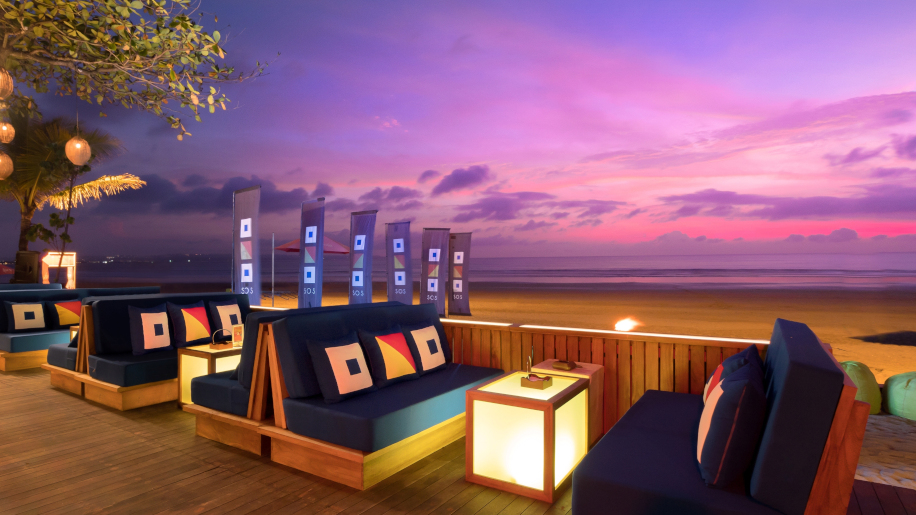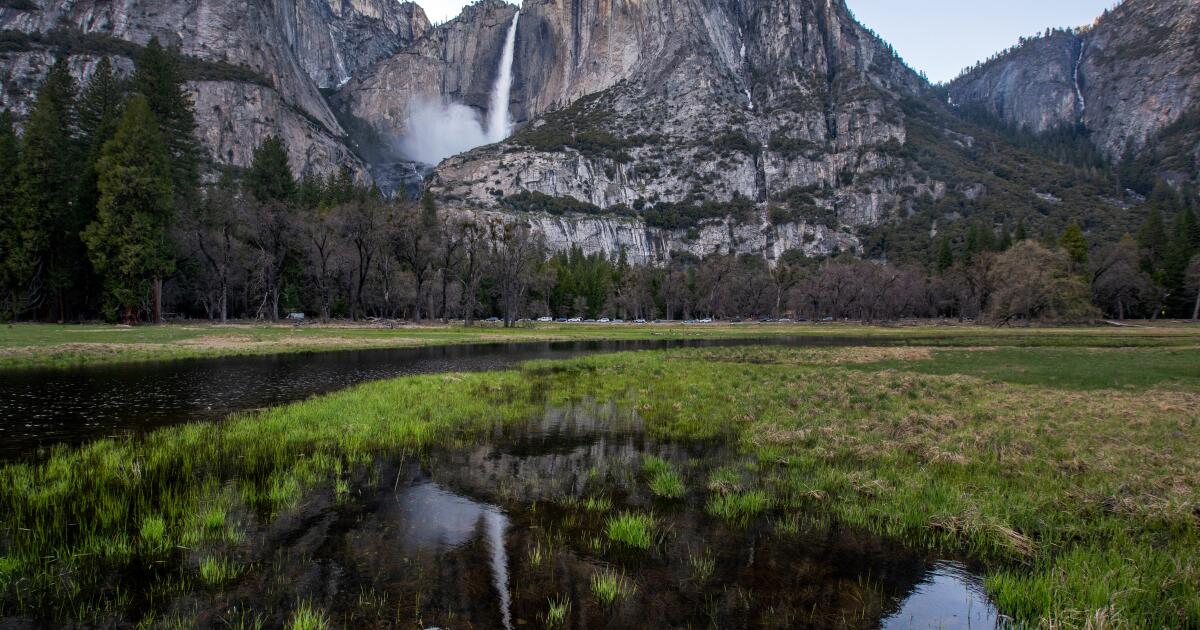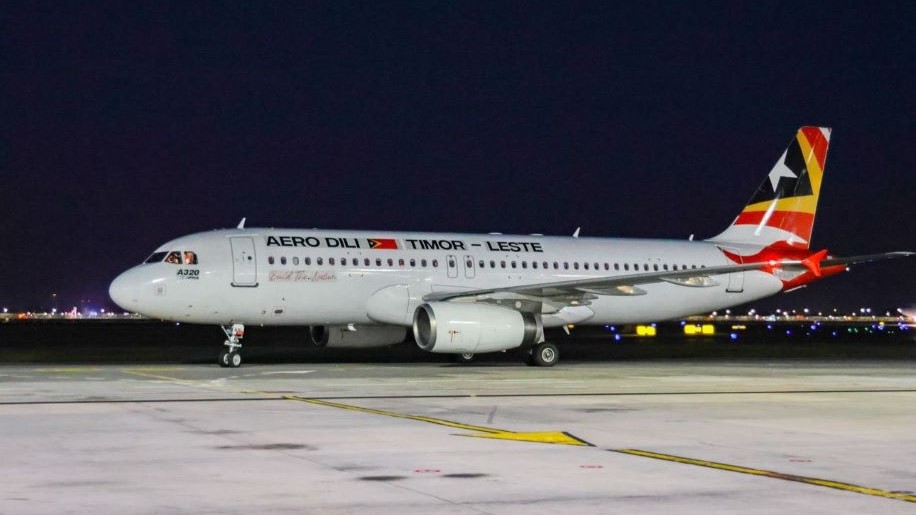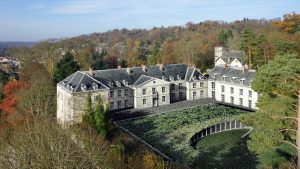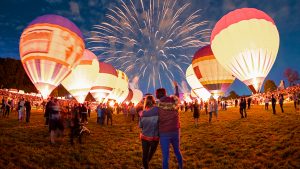At 10 a.m. on a recent Tuesday, the parking lot at McArthur-Burney Falls Memorial State Park was already full and the line of cars waiting to enter stretched well back from the entrance.
Next to the newly Instagram-famous waterfall, there was another line, this time of people, as everyone took turns getting what they were looking for: a photo of themselves in front of the glistening 129-foot wall of cascading water.
Erika Burgess, 29, who was on a road trip with her mother, said they made a point to stop at Burney Falls, in the foothills of the Cascade Mountain Range, about an hour east of Redding, after seeing a post about the experience on TikTok. Nearby, Cheryl Martinez was taking photos with her family. She said she found out about the falls on Instagram.
Sylvia Lubman and Roby McCabe enjoy the sparkling waters of Burney Falls.
(Paul Kuroda / For The Times)
America's public lands managers call it the “Instagram effect”: A view becomes geotagged on social media, and the resulting influx of selfie-seeking visitors can become overwhelming. Back in 2018, the Jackson Hole Travel and Tourism Board in Wyoming asked visitors to stop Geotag photographs of the area to prevent its most special places from being trampled. In California, the problem is familiar to forest rangers who police Joshua Tree, Yosemite and the towering redwood forests along the North Coast.
Now, post-COVID, the Insta-celebrity has arrived in the wooded ravines of rugged Shasta County. But unlike many of California's popular destinations, Burney Falls, which President Theodore Roosevelt once dubbed the “Eighth Wonder of the World,” is in the heart of “red” California, where residents have long suspected of the state government and its management of problems. long and small.
That includes traffic on State Highway 89, one of the county's main thoroughfares.
The entrance to McArthur-Burney Falls Memorial State Park is located on a curve in that road. When the parking lot fills up, as it does late in the morning on many days from spring to early fall, cars waiting to enter the park can be stuck in the road, causing backups that slow traffic. Some drivers stop waiting for a spot and park illegally on the narrow shoulder of the road. Others, in fits of frustration, make U-turns, sometimes into the path of oncoming logging trucks and other vehicles.
Bob Boyce, who lives about a mile from the park, said on weekends he can look out from his home and see traffic backed up for more than a mile. It's frightening. Drivers, he said, “come into that blind curve and there are people parked on the side of the road. “It's surprising that no one died.”
“All of us here love this park,” he added. “That's why we're concerned that we have this problem.”
Sandy McCullar, a Chamber of Commerce volunteer from the nearby town of Burney, said she loves the tourists who come to the park, but wishes state officials, who manage both the park and the highway, would do more to address the traffic.
“It's dangerous. It's not just bad. It's dangerous,” he said.
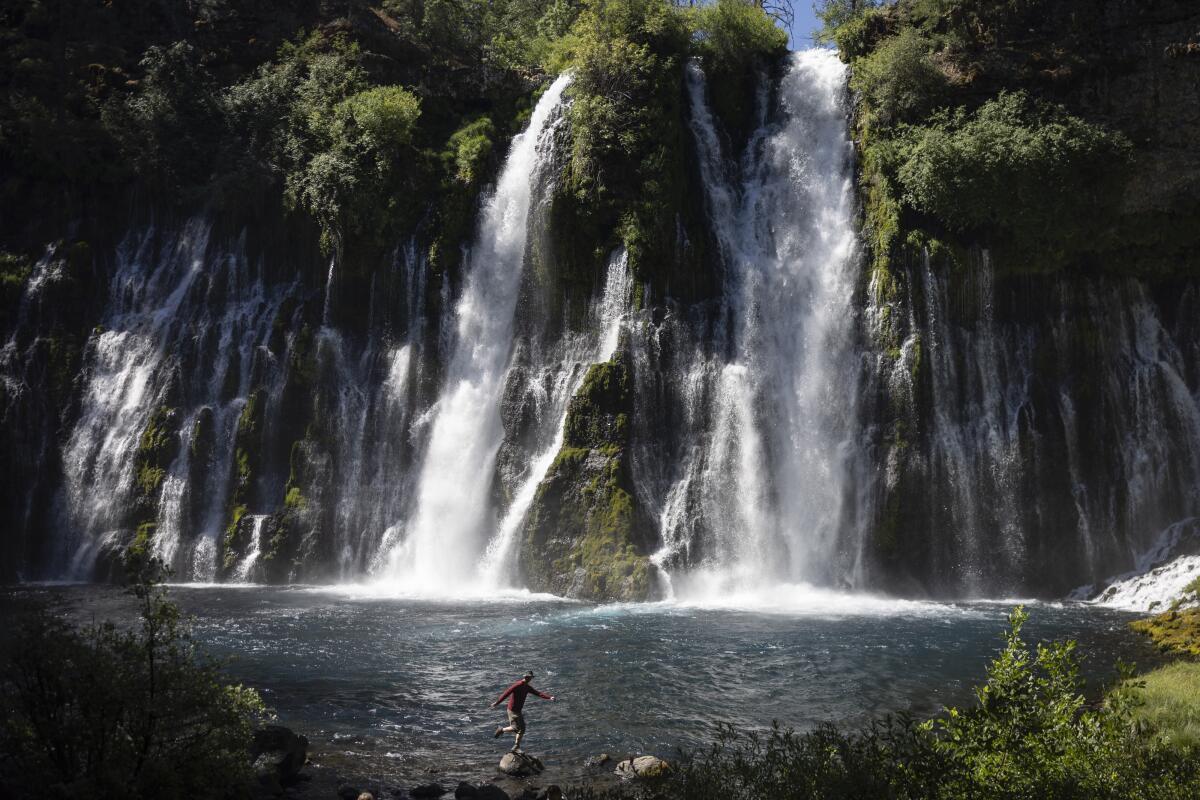
In the absence of a traffic solution in Burney Falls, officials are urging people to consider exploring less popular state parks. But none feature a 129-foot wall of water that generates vibrant rainbows.
(Paul Kuroda / For The Times)
State officials said they are doing everything they can to control the influx at the suddenly popular park. In recent months, the Parks and Recreation Department has launched its own social media campaign, essentially warning the public about the high chances of suffering misery if they attempt to visit Burney Falls.
“Expect long delays entering the park, full parking lots, and extreme frustration,” parks officials wrote in a June post on the McArthur-Burney Falls Facebook page.
The post continued, as if determined to make any potential visitor understand the difficulties they faced: “If the park reaches capacity while you are in line to enter, you will be turned away.”
And even if you get in, the publication warned, don't expect it to be all smooth sailing. The upper parking lots could be full and visitors could face “a 2-mile round trip uphill hike to see Burney Falls.” And to top it all off, the post said, visitors could have to contend with “long lines at the bathrooms” and “narrow, congested, slow-moving trails.”
The post included photos of people waiting in line to go to the bathroom and rows of cars stuck in traffic.
Some local leaders are calling for a more proactive and thoughtful solution than the state's, hoping to scare people away.
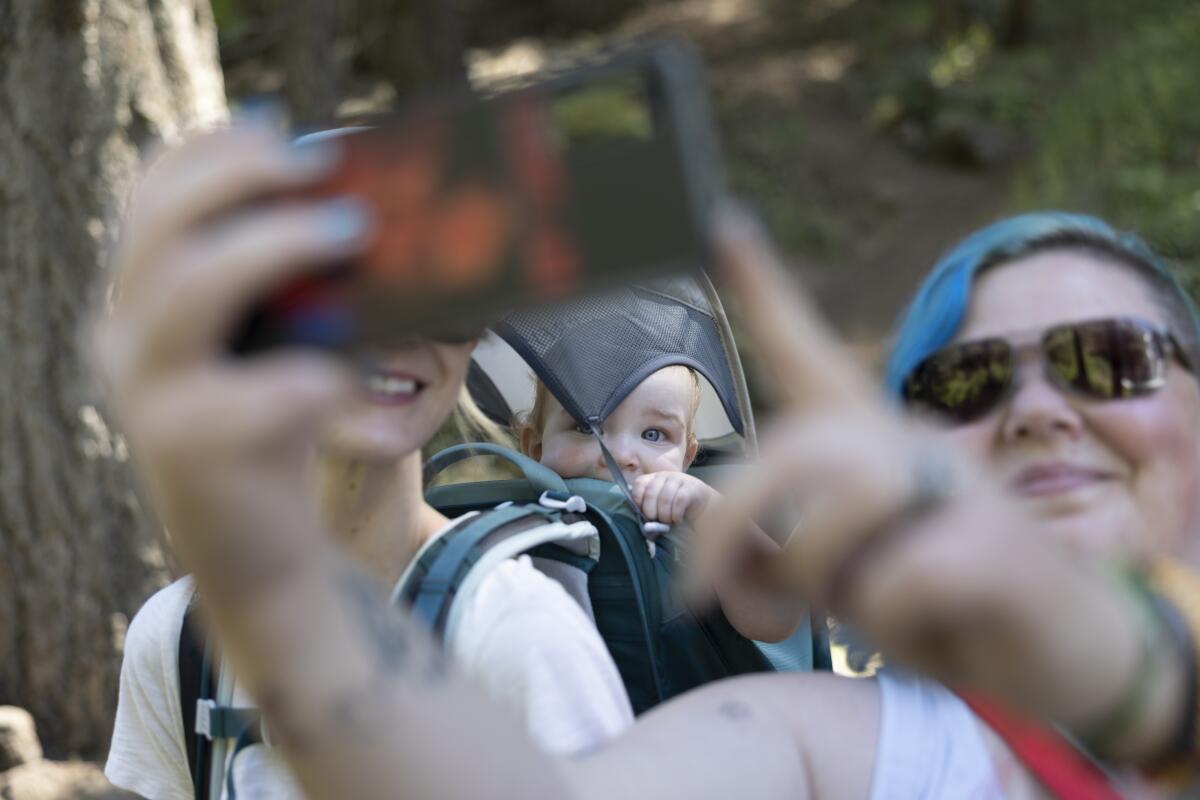
Visitors often have to wait in long lines to take a selfie at Burney Falls. Here, Rachel Brussbau poses with her 1-year-old daughter, Sage, and Crysten Michol.
(Paul Kuroda / For The Times)
Shasta County Supervisor Mary Rickert, whose district covers the park, said mountain towns near the struggling attraction need “the economic boom that this creates.” She wondered why state officials couldn't do more to control traffic, instead of simply closing the park when the parking lot fills up and crossing their fingers that traffic eventually resolves.
Why not offer a shuttle service from Burney, he said, which would be “an opportunity to help the community” by easing traffic on Highway 89 while also drawing people to the town's shops and restaurants. city.
One way or another, he stated, the State has to take more decisive measures. “I'm concerned about people's safety,” he said.
Jason De Wall, chief of the northern division of California State Parks, said park managers “have explored the idea of ferries,” but so far have not found vendors willing to operate them. “We spend a lot of time considering parking,” he added, not just at Burney Falls but at all state parks.
In the absence of a parking solution, state parks officials have urged people to consider visiting Burney Falls on a weekday or taking a trip to a less popular park.
Among California's least-visited parks, officials note, are the Kruse Rhododendron State Natural Reserve, near Jenner; Great Valley Grasslands State Park near Merced, which “preserves one of the few intact examples of native grasslands on the Central Valley floor”; and Arthur B. Ripley Desert Woodland State Park in Antelope Valley, which protects Joshua trees.
Of course, none of those other parks feature a 129-foot wall of water that generates its own vibrant rainbows daily.
Established a century ago, Burney Falls is the second-oldest state park in the California system, after Big Basin Redwoods in the Santa Cruz Mountains. Long considered sacred by the Pit River Indians, Burney Falls is located 15 miles from Burney Mountain. Snowmelt spills from the mountain into underground springs that gush above and into Burney Falls to create the waterfall. Rainbows burst from the falls in all directions and a cool mist floats across the ravine even on the hottest days of summer.
The area became a state park after members of the pioneer McArthur family became concerned that Pacific Gas & Electric was attempting to dam the Pit River to generate hydroelectric power and destroy the falls.
The strange thing for many locals is that for most of its 100-year history, Burney Falls was largely a local secret. Families from Redding came in the summer to escape the heat.
And then came the pandemic. There was a rush of outdoor recreation and outsiders discovered the falls. Many took to social media to post their photos. So it was.
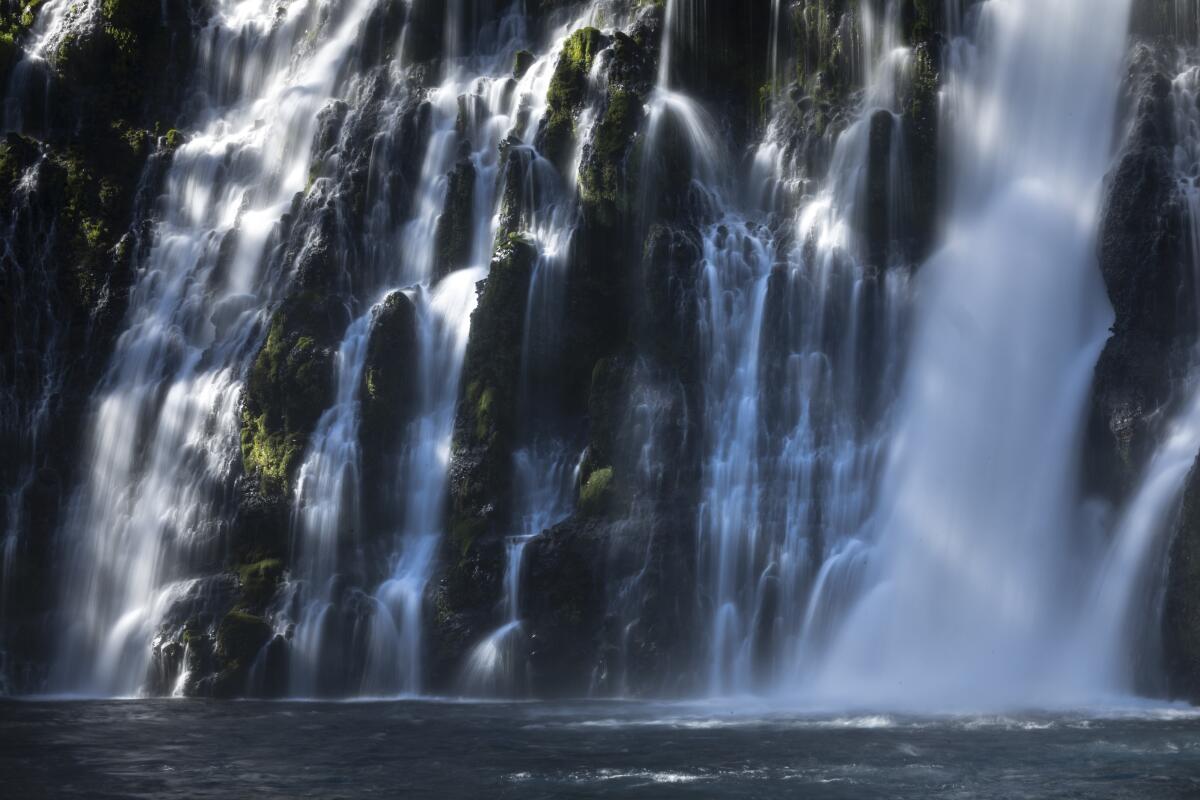
For much of its 100-year history, Burney Falls was a local secret. Families from Redding came in the summer to escape the heat.
(Paul Kuroda / For The Times)
Lately, some park visitors have also started posting about the crowds at the park. A post from the summer described the expectations of a visit to Burney Falls versus the reality. The “expectation” part of the TikTok video showed off the stunning beauty of the park. The “reality” part showed a trail full of people laboriously moving forward in single file.
Even in that video, however, the falls shone behind the human parade, striking in their beauty.
For now, residents like Boyce have accepted with a shrug that, despite their proximity to a natural wonder, Burney Falls is virtually out of reach all summer. “Too much of a headache to get in and there are too many people,” she said.
But when fall and winter arrive? “Oh, yes,” she said. “It's beautiful, absolutely beautiful.”

